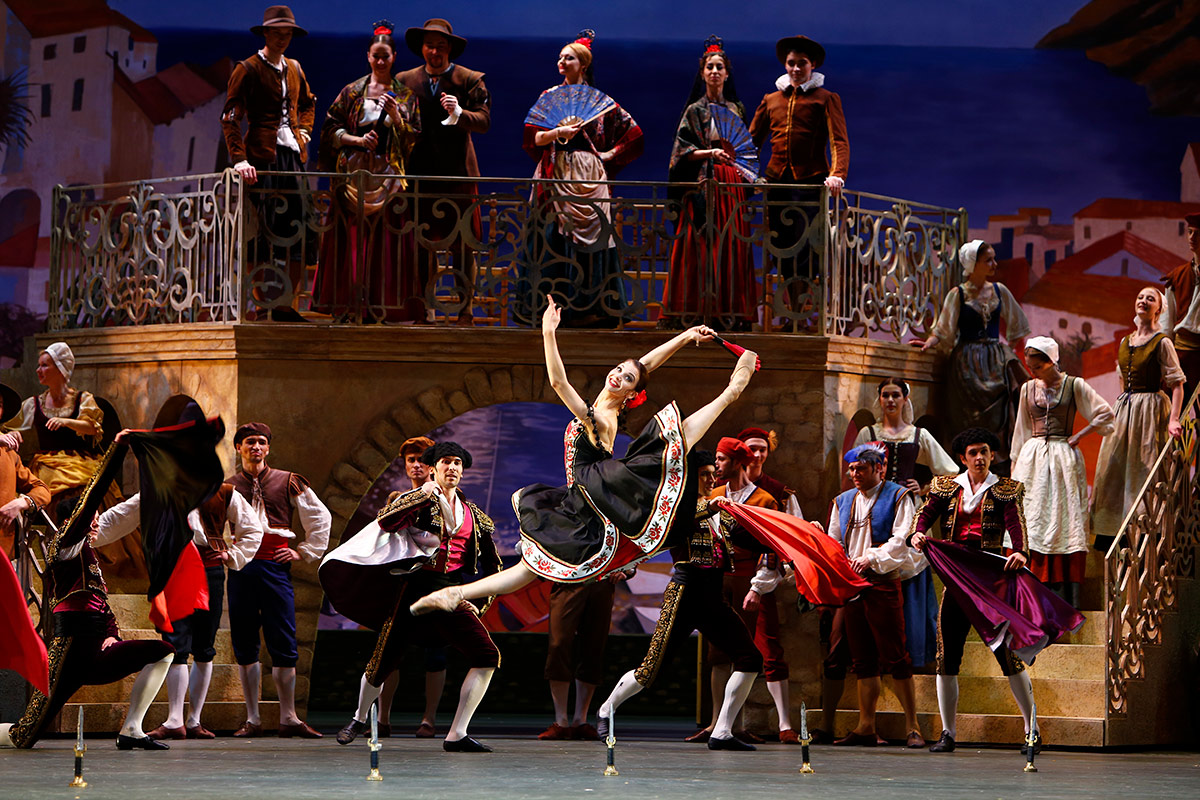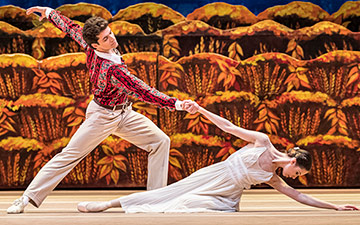
© Foteini Christofilopoulou. (Click image for larger version)
Bolshoi Ballet
Don Quixote
★★★★✰
London, Royal Opera House
15 August 2019
Gallery of pictures by Foteini Christofilopoulou
www.bolshoi.ru
www.roh.org.uk
This is the 2016 production of Don Quixote by Alexei Fadeyechev that the Bolshoi brought to London a few months after its Moscow premiere. It met with enthusiasm then, as it does now, for its sheer Bolshoi exuberance. It’s a ballet to show off the company, from the corps through to the principals, with plenty of opportunities for soloists and demi-soloists to shine. Like The Bright Stream earlier in the three-week season, the production displays the performers’ abilities as comic actors, character dancers and classical virtuosi.
Fadeyechev places Don Quixote, the elderly would-be-chivalrous knight, at the heart of the story. The bookish Don, lanky Alexei Loparevich, intervenes in the thwarted love match between Kitri, the innkeeper’s daughter, and Basil, a penniless barber. The old boy is ultimately responsible for their wedding celebrations in a grand castle instead of a tavern. Knocked unconscious by the sails of a windmill, he is rescued by a ducal hunting party; hearing of his adventures with the young couple, the Duke and Duchess agree to host the wedding reception, thus extending the ballet’s range of dance styles even further.
Most of the choreography is attributed to Marius Petipa and Alexander Gorsky, who restaged the ballet in 1900 as an ensemble spectacular. Three other Soviet choreographers are credited with folk dances to music that has nothing in common with Minkus’s ballet score, which has little to do with the Spanish setting of Cervantes’s original novel. It’s very danceable music, though, as in La Bayadère, Minkus’s idea of a vision scene sounds like a knees-up at a beer festival.

© Damir Yusupov. (Click image for larger version)
What the production does successfully is to integrate the different types of performers in the crowd scenes. In the town square and the tavern, they all dance with each other: only in the castle do white clad courtiers stick with their own kind. Margarita Shrainer as Kitri is natural as a small-town girl, admired by the locals but not the queen of the fiesta: that role is fought out between the professional street dance, Anna Tikhomirova, and Kristina Karasyova as Mercedes, Espada’s best girlfriend. Not until the wedding celebrations does Kitri rightfully claim centre stage as an undisputed ballerina, beyond class barriers.
Shrainer made her tentative debut as Kitri in London in 2016, when she was still in the corps (she’s now a first artist). She’s fearless, and so she should be, given that her Basil was sturdy Igor Tsvirko, a replacement for the advertised Ivan Vasiliev. I saw Tsvirko as Spartacus, a role in which he had no difficulties in accomplishing the powerful lifts, or in sustaining his stamina for repeated leaps and spins. Shrainer, however, is a handful as Kitri. She’s a febrile dancer, something of a windmill in the way her limbs fly up without a reliable core control to sustain them. She flings herself into the air, or is flung by Tsvirko, hoping for the best as she lands. Not surprisingly, the first of the one-arm lifts in the Act III grand pas didn’t come off, though the second one did, triumphantly.
Schrainer can do it all at speed – she’s not an adagio dancer – but her weakness is evident when compared with the stronger classical dancers around her, either in the Act II vision scene, with Antonina Chapkina as Queen of the Dryads, or with her girlfriends and bridesmaids, Daria Bochkova, Daria, Khokhlova and Anastasia Denisova. Schrainer does, however, have a rapport with Tsvirko’s Basil, which made their pas de deux a pleasure to watch. Less flamboyant than Vasiliev, he’s technically assured, though not yet a principal dancer; maybe the leading roles he has been given this season will convince him to stay with the Bolshoi instead of trying out other companies.
His Basil is an attractive philanderer in Act I, which establishes the central characters and the corps of townspeople in a vivid Spanish setting by Valery Leventhal, the Bolshoi’s former principal stage designer. Don Quixote and Sancho Panza arrive on foot, without a horse and donkey to ease their travels. They are invited to stay in the inn by Lorenzo, Kitri’s father. While he is distracted, Kitri and Basil run away together.

© Foteini Christofilopoulou. (Click image for larger version)
Fadeyechev treats the middle act of his Don Quixote as a cabaret of specialist turns, enlivening the slender plot and keeping the audience entertained. In the Act II scene set in a tavern, pseudo-Spanish dances follow each other in quick succession, with castanets, tambourines and stamping on the table top. Skirts swirl ever more extravagantly as performers compete to see who can accomplish the deepest backbend (Kristina Karasyova is particularly impressive as Mercedes). Three tipsy men burst into a jolly jig with a bouncy girl (Biriukova). The preening toreador, Espada, (Ruslan Skvortsov), has a go at a zapateado sequence in soft shoes without a heel, which makes him look absurd – which he is, in a glamorous way. He and his fellow bullfighters are proficient cape and dagger handlers, less camp than usual.
The liaison between Kitri and Basil is sorted in the tavern, so there’s no need for them to wander into the woods with the Don and Sancho Panza. The ensuing scene among gypsies and windmills drags because it has to cover scene and costume changes to the realm of the dryads. Anna Balukova tears a passion to shreds in her gypsy outfit in choreography by Kasiyan Goleizovsky, but we’ve already watched a lot of skirt dances in the tavern. A perfunctory puppet play serves to account for Don Quixote’s confused reaction to the drama and his subsequent hallucination about dryads and his imagined Dulcinea.
Apart from Basil, the main leading roles for men in this Don Q are comic ones. Loparevich manages to keep his dignity as the deluded Don, unlike his Sancho Panza squire, Alexei Matrakhov, a loveable rogue. He’s a real character, the Don’s carer as much as his servant. As Gamache, Kitri’s rich, silly suitor, Yuri Ostrovsky is an amiable idiot, wishing her well in the end. Very tall Alexander Fadeyechev is a hoot as Kitri’s bamboozled father, Lorenzo. He embraces his fellow tavern keeper, Dmitry Umnilov, in what must feel like a lethal grizzly bear hug. Basil gets the same treatment once his very fake suicide attempt softens Lorenzo’s heart.
The reason the Bolshoi’s Don Quixote is so enjoyable is the gusto with which it is performed. It doesn’t aim to be remotely authentically Spanish or even respectful of the original 1869 version by Petipa. Its vision scene isn’t as elegant as the Mariinsky’s but its character dancers are unmatched. I do miss the mature performers, now retired, who coach their slender young replacements, ensuring that the Bolshoi tradition endures. I miss Natalia Osipova and Ivan Vasiliev in their prime as the mischievous lovers, but this Don Q is as much about the company as about its principal casts. It makes a joyous ending to this year’s Russian ballet season at the Royal Opera House. There won’t be another one next year, until the Mariinsky Ballet is due, we hope, in 2021.

















You must be logged in to post a comment.